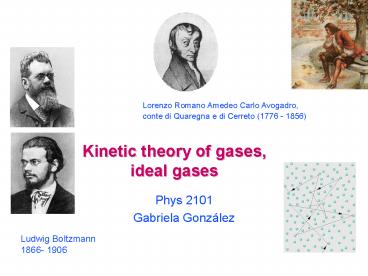Kinetic theory of gases, ideal gases - PowerPoint PPT Presentation
1 / 10
Title:
Kinetic theory of gases, ideal gases
Description:
Kinetic theory of gases, ideal gases. Phys 2101. Gabriela Gonz lez. Lorenzo Romano Amedeo Carlo Avogadro, conte di Quaregna e di Cerreto (1776 - 1856) ... – PowerPoint PPT presentation
Number of Views:730
Avg rating:3.0/5.0
Title: Kinetic theory of gases, ideal gases
1
Kinetic theory of gases, ideal gases
Lorenzo Romano Amedeo Carlo Avogadro, conte di
Quaregna e di Cerreto (1776 - 1856)
- Phys 2101
- Gabriela González
Ludwig Boltzmann 1866- 1906
2
1st Law special cases
- First Law of thermodynamics ?Eint Q
W - Special processes
- Adiabatic Q0 ? ?Eint W
- thermally insulated system, or
- very quick process
- Constant Volume W0 ? ?Eint Q
- Cyclical ?Eint 0 ? Q W
- Free expansion Q W 0 ? ?Eint 0
- happens in isolated systems
3
Example
- Figure (a) shows a cylinder containing gas and
closed by a movable piston. The cylinder is kept
submerged in an ice water mixture. The piston is
quickly pushed down from position 1 to position 2
and then held at position 2 until the gas is
again at the temperature of the ice water
mixture it then is slowly raised back to
position 1. Figure (b) is a p-V diagram for the
process. If 140 g of ice is melted during the
cycle, how much work has been done on the gas?
4
Kinetic theory of gases
- At the microscopic level,
- temperature is a measure of the kinetic energy
in the elemental units (atoms or molecules) - pressure exerted by a gas is produced by
molecular collisions on the walls of its
container - the fact that gases fill up the volume of the
container theyre in is due to the freedom of the
molecules to move around.
5
Avogadros law
Lorenzo Romano Amedeo Carlo Avogadro, conte di
Quaregna e di Cerreto (1776 - 1856)
Avogadros law (1811) equal volumes of gases, at
the same temperature and pressure, contain the
same number of molecules.
Useful unit for number of atoms moles 1 mole
number of atoms in a 12g sample of carbon-12
6.02 1023 (Avogadros number) number of
moles total number of molecules / NA
total mass /
mass of one mole
total mass /(molecular mass x NA)
6
Avogadros number
- An Avogadro's number of standard soft drink cans
would cover the surface of the earth to a depth
of over 200 miles. - If you had Avogadro's number of unpopped popcorn
kernels, and spread them across the United States
of America, the country would be covered in
popcorn to a depth of over 9 miles. - If we were able to count atoms at the rate of 10
million per second, it would take about 2 billion
years to count the atoms in one mole.
7
Example
- Gold has a molar mass of 197 g/mol.
- How many moles of gold are in a 2.50g sample of
pure gold? - How many atoms are in the sample?
- If we were able to count atoms at the rate of 10
million per second, it would take about 2 billion
years to count the atoms in one mole. - TRUE OR FALSE?
8
Ideal Gases
- All gases approach a unique ideal gas at low
densities. - An ideal gas obeys the ideal gas law
- p V n R T N k T
- p absolute pressure (Pa)
- V volume (m3)
- n number of moles
- T temperature (kelvin)
- R gas constant 8.31 J/(mole K) k NA
- k Boltzmanns constant 1.38 10-23 J/K
- N number of molecules
Ludwig Boltzmann 1866- 1906
9
Work done by an ideal gas
pVnRT
- Constant temperature keep temperature
constant, change the volume. The pressure will
change, following p nRT/V - How much work is done by the gas?
W nRT ln (Vf/Vi) - Constant pressure keep pressure constant,
change the volume. The temperature will change,
following TpV/nR. How much work is done by the
gas? W p ?V p(Vf-Vi)
- Constant volume pressure and temperature may
change, but no work is done! - W 0
isotherms
10
Example
- A gas can be taken from the initial state i to
the final state f in many different ways, usually
following constant pressure curves, constant
volume curves, and isotherms. - If the initial pressure is 1Pa, and the
initialvolume is 1m3, how many moles are
therein the gas? - If the final volume is 1.1 m3, what is the
final pressure? - What is the path from i to f where the gas does
minimum work? - What is the temperature at intermediate points
A, B? - If the system is taken to the final state
through the 310 K isotherm, and then back to the
original state through point B, what is the total
heat added to the system?
B
A































